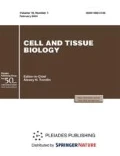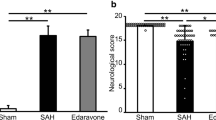Abstract—
In rats subjected to traumatic brain injury (TBI), at the stage of acute development of traumatic disease, the platelet number, ultrastructural changes in liver sinusoid hemocapillaries (SCs), and microcirculation disorders in their lumen were studied. The results of the study showed that, in local brain injury, on the third day of post-traumatic period, thrombocytopenia, expressed lesions of liver SCs, and intrasinusoid microcirculation disorders, which are aggravated on the seventh day post injury, are detected. On the 12th day after TBI, the sinusoid endothelium is detected to be of usual appearance, but yet areas of its swelling and edema occur. In 79% of sinusoid hemocapillaries, the blood flow is recovered, while in 21% macro- and micro aggregates of erythrocytes, bubbles, cellular detritus, and platelets are detected. Analyzing the obtained data, we can conclude that the detected lesions of liver SC endotheliocytes in the acute period of TBI make it possible to consider them one of the key, and earliest, links of pathogenesis of the vascular–platelet link of hemostasis.





Similar content being viewed by others
REFERENCES
Ageev, F.T., Correction of endothelial dysfunction—a key to successful treatment of cardiovascular diseases, Zh. Serdechn. Nedostat., 2003, vol. 4, no. 1, pp. 54–60.
Augustin, H., Kozian, D., and Johason, R., Differentiation of endothelial cells: analysis of the constitutive and activated endothelial cellphenotypes, Bioessays, 1994, vol. 16, pp. 901–907.
Avakimyan, S.V., Karipidi, G.K., Avakimyan, V.A., Storozhuk, P.G., and Vagin, I.V., Disturbances in the hemostatic system in patients with acute pancreatitis and its correction, Kuban. Nauchn. Med. Vestn., 2013, vol. 142, no. 7, pp. 38–40.
Belousov, Yu.V. and Namsaraev, Zh.N., Endothelial dysfunction as a cause of atherosclerotic lesions of arteries in hypertension: correction methods, Farmateka, 2006, vol. 84, no. 6, pp. 12–17.
Boyarinov, G.A.., Disseminated intravascular coagulation (DIC syndrome), in Izbrannye lektsii “Osnovy intensivnoi terapii v khirurgicheskoi klinike” (Fundamentals of Intensive Care in Surgical Clinical Practice: Selected Lectures), Nizhni Novgorod, 1992, pp. 61–101.
Boyarinov, G.A., Boyarinova, L.V., Deryugina, A.V., Solov’eva, O.D, Zaitsev, R.R., Voennov, O.V., Moshnina, E.V., and Shumilova, A.V., The role of secondary brain damage factors in the activation of vascular-platelet hemostasis in traumatic brain injury, Obshch. Reanimatol., 2016a, vol. 12, no. 5, pp. 42–51.
Boyarinov, G.A., Boyarinova, L.V., Deryugina, A.V., Zaitsev, R.R., Solov’eva, O.D., and Yakovleva, E.I., Pharmacological correction of changes in vascular-platelet hemostasis in traumatic brain injury, Med. Al’manakh, 2016b, vol. 41, no. 1, pp. 139–144.
Boyarinov, G.A., Deryugina, A.V., Zajtsev, R.R., Boyarinova, L.V., Yakovleva, E.I., Solov’eva, O.D., Nikol’skij, V.O., Galkina, M.V., and Martusevich, A.A., Morphological changes in myocardial blood microvessels in experimental traumatic brain injury, Obshch. Reanimatol., 2016c, vol. 12, no. 2, pp. 20–29.
Boyarinov, G.A., Deryugina, A.V., Zajtsev, R.R., Boyarinova, L.V., Yakovleva, E.I., Solov’eva, O.D., Nikol’skij, V.O., Galkina, M.V., and Martusevich, A.A., Pharmacological correction of microcirculation in rats after traumatic brain injury, Tsitologiia, 2016d, vol. 58, no. 8, pp. 610–617.
Cherkasov, V.A., Schekotova, A.P., Latysheva, S.E., and Zagorodskikh, E.B., New opportunities for predicting the complications of acute pancreatitis and evaluating the effectiveness of treatment, Perm.Med. Zh., 2013, vol. 30, no. 2, pp. 10–15.
Chernukh, A.M., Aleksandrov, P.N., and Alekseev, O.V., Mikrotsirkulyatsiya (Microcirculation), Moscow: Meditsina, 1975.
Endemann, D.H. and Schiffrin, E.L., Endothelial dysfunction, J. Am. Soc. Nephrol., 2004, vol. 15, pp. 1983–1992.
Firsov, S.A. and Matveev, R.P., Endothelial dysfunction and its prognostic value in critical conditions as a result of road traffic injuries, Sovrem. Probl. Nauki Obraz., 2014, vol. 6. http://science-education.ru/ru/article/view?id=16629.
Hoffman, M.A. and Monroe, D.M., 3rd., Cell-based model of hemostasis, Thromb. Haemost., 2001, vol. 85, pp. 958–965.
Ivanov, S.N., Starovojtova, E.A., Ogorodova, L.M., and Volkova, T.G., The role of endothelial dysfunction in the pathogenesis of cardiovascular disease, Sib. Med. Zh., 2007, vol. 22, no. 1, pp. 99–102.
Juratli, T.A., Zang, B., Litz, R.J., Sitoci, K.H., Aschenbrenner, U., Gottschlich, B., Daubner, D., Schackert, G., and Sobottka, S.B., Early hemorrhagic progression of traumatic brain contusions: frequency, correlation with coagulation disorders, and patient outcome: a prospective study, J. Neurotrauma, 2014, vol. 31, pp. 1521–1527.
Kalinin, R.E., Integrated assessment of the functional state of endothelium in patients with atherosclerosis obliterans of lower limb arteries at different methods of surgical treatment, Extended Abstract of Doctoral Dissertation, Ryazan, 2008.
Korzh, A.N., The value of endothelial dysfunction in the development of diseases of the cardiovascular system, Mezhdunar. Med. Zh., 2003, vol. 3, pp. 10–14.
Kozlov, V.I., Mel’man, E.P., Nejko, E.M., and Shutka, B.V., Gistofiziologiya kapillyarov (Histophysiology of Capillaries), St. Petersburg: Nauka, 1994.
Mel’nikova, Yu.S. and Makarova, T.P., Endothelial dysfunction as the key element of pathogenesis of chronic diseases, Kazan. Med. Zh., 2015, vol. 96, no. 4, pp. 659–665.
Oertel, M., Kelly, D.F., McArthur, D., Boscardin, W.J., Glenn, T.C., Lee, J.H., Gravori, T., Obukhov, D., McBride, D.Q., and Martin, N.A., Progressive hemorrhage after head trauma: predictors and consequences of the evolving injury, J. Neurosurg., 2002, vol. 96, pp. 109–116.
Poroiskii, S.V., Voronkov, A.V., Tyurenkov, I.N., Bulycheva, O.S., and Samoilova, O.S., Endothelial dysfunction in surgery—a modern view of the problem, Vestn. Vol. Gos. Med. Univ., 2011, vol. 39, no. 3, pp. 13–17.
Potapov, A.A., Likhterman, L.B., Kravchuk, A.D., Okhlopkov, V.A., Aleksandrova, E.V., Filatova, M.M., Maryakhin, A.D., and Latyshev, Ya.A., Legkaya cherepno-mozgovaya travma. Klinicheskie rekomendatsii (Mild Traumatic Brain Injury: Clinical Guidelines), Moscow, 2016.
Reshetnyak, V.I., Zhuravel’, S.V., Kuznetsova, N.K., Pisarev, V.M., Klychnikova, E.V., Syutkin, V.E., and Reshetnyak, T.M., Hemostasis system in normal state and in liver transplantation (review), Obshch. Reanimatol., 2018, vol. 14, no. 5, pp. 58–84.
Schwarzmaier, S.M., Kim, S.W., Trabold, R., and Plesnila, N., Temporal profile of thrombogenesis in the cerebral microcirculation after traumatic brain injury in mice, J. Neurotrauma, 2010, vol. 27, no. 1, pp. 121–130.
Semchenko, V.V., Voinov, A.Yu., Golevtsova, Z.Sh., Govorova, N.V., and Scherbakov, P.N., Gemostaz i sosudistyi endotelii pri cherepno-mozgovoi travme (Hemostasis and Vascular Endothelium in Traumatic Brain Injury), Omsk: Omsk. Oblast. Tipogr., 2003.
Shapkin, Yu.G., Stekolьnikov, N.Yu., Gamzatova, P.K., and Mamedova, M.M., Possibilities of correction of endothelial dysfunction in severe cold injuries Sovrem.Nauka: Aktual. Probl. Teorii Prakt., 2017, vol. 20, pp. 106–109.
Shapovalov, K.G., Sizonenko, V.A., Tomina, E.A., and Vitkovskii, Yu.A., Endothelial secretion of vasoactive molecules during cold injury of extremities, Travmatol. Ortoped. Rossii, 2008, vol. 48, no. 2, pp. 53–56.
Shilov, A.V., Mnikhovich, M.V., Kalinin, R.E., Suchkov, I.A., Kakturskii, L.V., Rudnitskii, S.V., and Nechaev, L.V., Morphological changes in the vessel wall in endothelial dysfunction, Zh. Anat. Gistopatol., 2017, vol. 6, no. 2, pp. 115–121.
Shilov, A.V., Mnikhovich, M.V., Kalinin, R.E., Kokturskii, L.V., Suchkov, I.A., Rudnitskii, S.V., Mashkovtsev, O.I., and Kazantseva, G.P., Adaptive and pathological changes in the endothelium at L-NAME-induced dysfunction in the experiment, Vestn. Novykh Med. Tekhnol., 2018, vol. 12, no. 4, pp. 282–286.
Stein, S.C., Spettell, C., Young, G., and Ross, S.E., Delayed and progressive brain injury in closed-head trauma: radiological demonstration, Neurosurgery, 1993, vol. 32, pp. 25–30.
Stein, S.C., Chen, X.H., Sinson, G.P., and Smith, D.H., Intravascular coagulation: a major secondary insult in nonfatal traumatic brain injury, J. Neurosurg., 2002, vol. 97, pp. 1373–1377.
Suchkov, I.A., Correction of endothelial dysfunction: the current state of the problem (literature review), Ross. Med.-Biol. Vestn.im.Akademika I.P. Pavlova, 2012, vol. 4, pp. 151–157.
Tercan, M. and Bekerecioglu, M., Decreased serum nitric oxide level in experimental frostbite injury: a preliminary study, Ann. Plast. Surg., 2002, vol. 48, pp. 107–108.
Tomina, E.A., Shapovalov, K.G., and Vitkovskii, Yu.A., Serum nitrite content in patients with local cold injury, Byull. VSNTS Sib. Otd. Ross. Akad. Med. Nauk, 2008, vol. 61, no. 3, pp. 160–161.
Tsymbalyuk, V.I. and Kochin, O.V., Experimental modeling of traumatic brain injury, Ukr. Neirokhir. Zh., 2008, vol. 2, pp. 10–12.
Vasil’ev, S.A., Melkumyan, A.L., Berkovskij, A.L., Suvorov, A. V., Mazurov, A.V., and Kozlov, A.A., Kliniko-laboratornaya diagnostika narushenii funktsii trombotsitov. Metodicheskoe posobie (Clinical and Laboratory Diagnosis of Platelet Function Disorders: Methodological Guidance), Moscow, 2017.
Vinnik, Yu.S., Yur’eva, M.Yu., Teplyakova, O.V., Salmina, A.B., and Tret’yakova, N.G., The role of endothelial dysfunction in the pathogenesis of local cold injury, Med. Obozr., 2014, vol. 22, no. 31, pp. 2204–2206.
Vinnik, Yu.S., Dunaevskaya, S.S., Antyufrieva, D.A., and Deulina, V.V., Endothelial dysfunction and the development of organ failure in acute pancreatitis, Sovrem. Probl. Nauki Obraz., 2018, vol. 5. http://science-education.ru/ru/article/view?id=27889.
Voinov, A.Yu., Golevtsova, Z.Sh., and Semchenko, V.V., Hemostasis and vascular endothelium in severe traumatic brain injury, Byull. Sib. Otd. Ross. Akad. Med. Nauk, 2002, vol. 3, pp. 35–44.
Vorob’eva, E.N., Shumakher, G.I., Khoreva, M.A., and Osipova, I.V., Endothelial dysfunction—a key component in the pathogenesis of atherosclerosis, Ross. Kardiol. Zh., 2010, vol. 82, no. 2, pp. 84–91.
Zubairov, D.M., Matrix hypotheses of enzymatic cascade during blood coagulation, Probl. Gematol., 1980, vol. 25, no. 3, pp. 4–10.
Funding
This work was carried out as part of the research work of the Anesthesiology and Intensive Care Department, Additional Professional Education Faculty, Privolzhsky Research Medical University of Ministry of Public Health of Russian Federation, Russia, and supported by the Russian Foundation for Basic Research, project no. 18-34-00831.
Author information
Authors and Affiliations
Corresponding authors
Ethics declarations
Conflict of interest. The authors declare that they have no conflict of interest.
Statement on the welfare of animals. Animal keeping and manipulations of them were performed according to the regulations presented in the Guide for Care and Use of Laboratory Animals (ILAR publication, 1996, National Academy Press) and the demands of the Order of Ministry of Public Health of Russia no. 267 of June 19, 2003, “On the Establishment of Rules of Laboratory Practice in Russian Federation.”
Additional information
Abbreviations: SC—liver sinusoid hemocapillary, TF—tissue factor, TBI—traumatic brain injury.
Rights and permissions
About this article
Cite this article
Boyarinov, G.A., Yakovleva, Y.I., Deryugina, A.V. et al. The Role of Endotheliocytes of Liver Sinusoid Capillaries in the Pathogenesis of Disorders in the Vascular-Platelet Link of Hemostasis in the Acute Period of Traumatic Brain Injury. Cell Tiss. Biol. 14, 43–51 (2020). https://doi.org/10.1134/S1990519X20010046
Received:
Revised:
Accepted:
Published:
Issue Date:
DOI: https://doi.org/10.1134/S1990519X20010046




